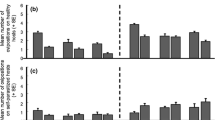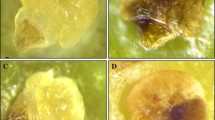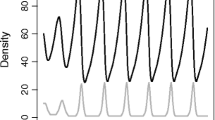Summary
Host discrimination, i.e. the ability to distinguish unparasitized hosts from parasitized ones, and to reject the latter for egg laying is present in many parasitic wasp species. This property is classically considered as an example of contest competition, and is supposed to have a number of functions. However, different species do not react to each other's marks and lay eggs in hosts parasitized by the other species. Apparently the marks used for recognition are specific.
Multiparasitization is the best strategy when hosts are scarce and the egg supplies of the parasitoids are not limited. Interspecific host discrimination is not an ESS.
Superparasitization within one species would have selective advantage if the number of unparasitized hosts is small and the wasp has a reasonable chance to lay her egg in a host that is not parasitized by herself, and if the chance for her offspring to survive the competitive battle with the first parasitoid larva is not too small. This is shown to be the case.
However, marks are not individual and wasps cannot distinguish hosts parasitized by themselves from those parasitized by others. The hypothesis is tested that the egg laying strategy (i.e. the decision to superparasitize) of wasps is dependent on the number of conspecifics that is searching simultaneously for hosts, since this determines the chance that a parasitized host encountered by a wasp is parasitized by herself.
It is shown that host discrimination cannot be regarded as a case of contest competition. Other aspects of superparasitization, related to interference and population regulation, sex allocation and encapsulation are briefly discussed.
Similar content being viewed by others
References
Alphen JJM van (1980) Aspects of the foraging behaviour ofTetrastichus spec. (Eulophidae), gregarious egg parasitoids of the asparagus beetlesCrioceris asparagi L. andC. duodecimpunctata L (Chrysomelidae) I Host-species selection, host-stage selection and host discrimination. Neth J Zool 30:307–325
Alphen JJM van, Nell HW (1982) Stiperparasitism and host discrimination byAsobara tabida Nees (Braconidae, Alysiinae) a larval parasitoid of Drosophilidae. Neth J Zool 32:232–260
Bakker K, Bagchee SB, Zwet WR van, Meelis E (1967) Host discrimination inPseudeucoila bochei (Hymenoptera: Cynipidae). Ent exp & appl 10:295–311
Bakker K, Eijsackers HJP, Lenteren JC van, Meelis E (1972) Some models describing the distribution of eggs of the parasitePseudeucoila bochei (Hym., Cynip.) over its hosts, larvae ofDrosophila melanogaster. Oecologia (Berl) 10:29–57
Eijackers HJP, Bakker K (1971) Elimination by physical attack of supernumerary larvae ofPseudeucoila bochei (Cynipidae) in their hosts, larvae ofDrosophila. Neth J Zool 21:205–207
Hassell MP (1978) The dynamics of arthropod predator-prey systems. Monographs in Population Biology 13, Princeton University Press
Lenteren JC van (1976) The development of host discrimination and the prevention of superparasitism in the parasitePseudeucoila bochei (Hym.: Cynipidae). Neth J Zool 26:1–83
Lenteren JC van (1981) Host discrimination in parasitoids. In: Nordlund (ed) Semiochemicals: their role in pest control. Wiley and Sons pp 153–179
Lenteren JC van, Bakker K (1975) Discrimination between parasitized and unparasitized hosts in the parasitic waspPseudeucoila bochei: a matter of learning. Nature 254 no 5499:417–419
Lenteren JC van, Nell HW, Sevenster-van der Lelie LA, Woets J (1976) The parasite-host relationship betweenEncarsia formosa (Hymenoptera: Aphelinidae) andTrialeurodes vaporariorum (Homoptera: Aleyrodidae) III Discrimination between parasitized and unparasitized hosts by the parasite. Z Ang Ent 81:377–380
Lenteren LC van, Bakker K, Alphen JJM van (1978) How to analyse host discrimination. Ecol Ent 3:71–75
Nicholson AJ (1954) An outline of the dynamics of animal populations. Austr J Zool 2:9–65
Parker GA, Courtney SP (1984) Models of clutch size in insect oviposition. Theor Pop Biol 26:27–48
Strien-van Liempt WTFH van (1983) The course of competition betweenAsobara tabida Nees andLeptopilina heterotoma (Thomson) in multiparasitized hosts. Neth J Zool 33:125–163
Strien-van Liempt WTFH van, Alphen JJM van (1981) The absence of interspecific host discrimination inAsobara tabida Nees (Hym.: Braconidae) andLeptopilina heterotoma (Hym.: Eucoilidae), coexisting larval parasites ofDrosophila species. Neth J Zool 31:701–712
Turlings TCJ, Batenburg FHD van, Strien-van Liempt WTFH van (1985) Why is there no interspecific host discrimination in the two coexisting larval parasitoids ofDrosophila species:Leptophilina heterotoma (Thomson) andAsobara tabida (Nees). Oecologia (Berlin) (in press)
Vet LEM, Meyer M, Bakker K, Alphen JJM van (1984) Intra-and interspecific host discrimination inAsobara (Hymenoptera), larval endo-parasitoids of Drosophilidae: comparison between closely related and less closely related species. Anim Behav 32:871–874
Author information
Authors and Affiliations
Rights and permissions
About this article
Cite this article
Bakker, K., van Alphen, J.J.M., van Batenburg, F.H.D. et al. The function of host discrimination and superparasitization in parasitoids. Oecologia 67, 572–576 (1985). https://doi.org/10.1007/BF00790029
Received:
Issue Date:
DOI: https://doi.org/10.1007/BF00790029




